Understanding Self-Injury Behavior
VerifiedAdded on 2020/06/04
|10
|2163
|416
AI Summary
This assignment delves into the complex issue of self-injury behavior in children. It identifies common forms of self-harm, such as head banging, scratching, and throwing oneself to the floor, and discusses factors contributing to these behaviors. The focus is on understanding the challenges associated with addressing self-injury and exploring potential interventions that can promote positive behavioral change.
Contribute Materials
Your contribution can guide someone’s learning journey. Share your
documents today.

Promote positive Behaviour
Secure Best Marks with AI Grader
Need help grading? Try our AI Grader for instant feedback on your assignments.
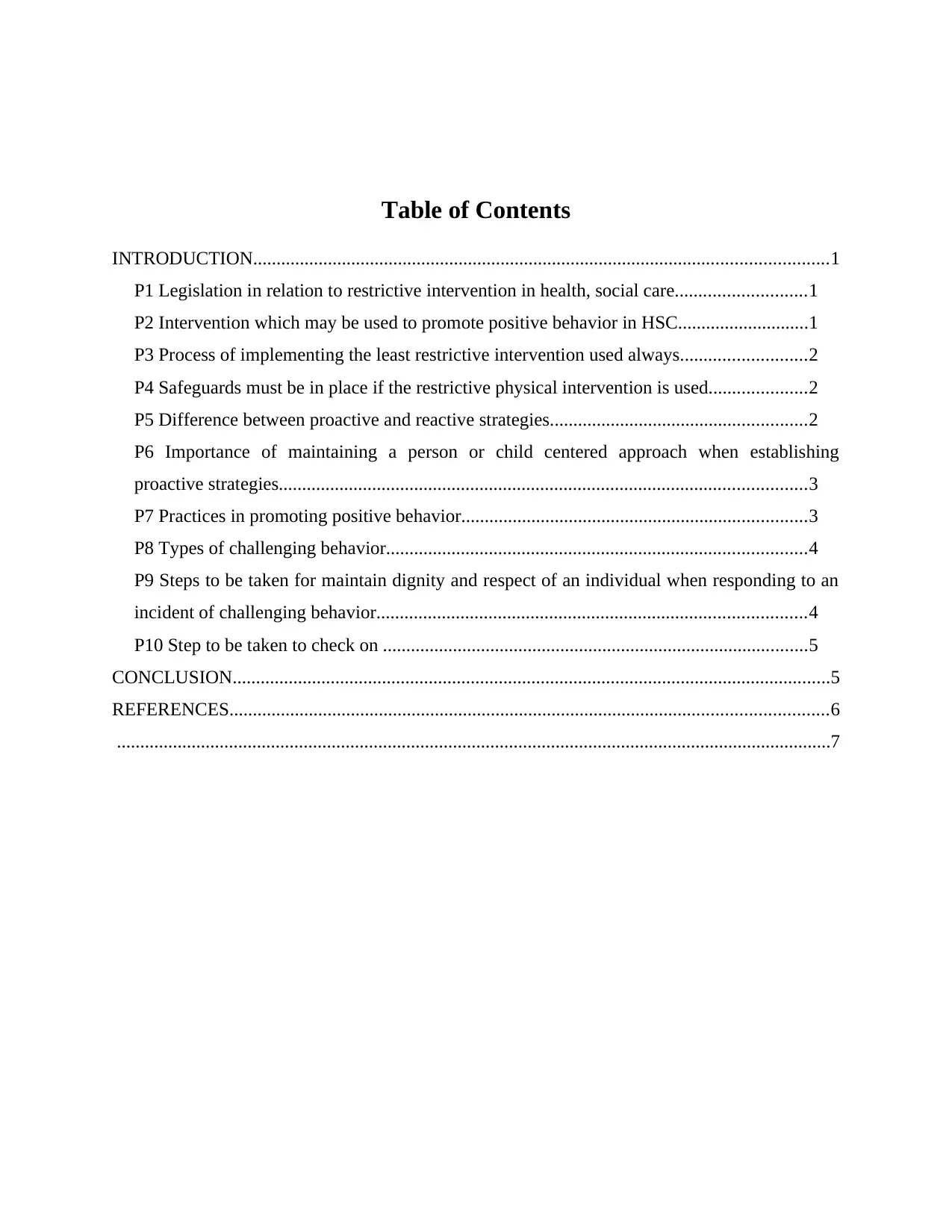
Table of Contents
INTRODUCTION...........................................................................................................................1
P1 Legislation in relation to restrictive intervention in health, social care............................1
P2 Intervention which may be used to promote positive behavior in HSC............................1
P3 Process of implementing the least restrictive intervention used always...........................2
P4 Safeguards must be in place if the restrictive physical intervention is used.....................2
P5 Difference between proactive and reactive strategies.......................................................2
P6 Importance of maintaining a person or child centered approach when establishing
proactive strategies.................................................................................................................3
P7 Practices in promoting positive behavior..........................................................................3
P8 Types of challenging behavior..........................................................................................4
P9 Steps to be taken for maintain dignity and respect of an individual when responding to an
incident of challenging behavior............................................................................................4
P10 Step to be taken to check on ...........................................................................................5
CONCLUSION................................................................................................................................5
REFERENCES................................................................................................................................6
.........................................................................................................................................................7
INTRODUCTION...........................................................................................................................1
P1 Legislation in relation to restrictive intervention in health, social care............................1
P2 Intervention which may be used to promote positive behavior in HSC............................1
P3 Process of implementing the least restrictive intervention used always...........................2
P4 Safeguards must be in place if the restrictive physical intervention is used.....................2
P5 Difference between proactive and reactive strategies.......................................................2
P6 Importance of maintaining a person or child centered approach when establishing
proactive strategies.................................................................................................................3
P7 Practices in promoting positive behavior..........................................................................3
P8 Types of challenging behavior..........................................................................................4
P9 Steps to be taken for maintain dignity and respect of an individual when responding to an
incident of challenging behavior............................................................................................4
P10 Step to be taken to check on ...........................................................................................5
CONCLUSION................................................................................................................................5
REFERENCES................................................................................................................................6
.........................................................................................................................................................7
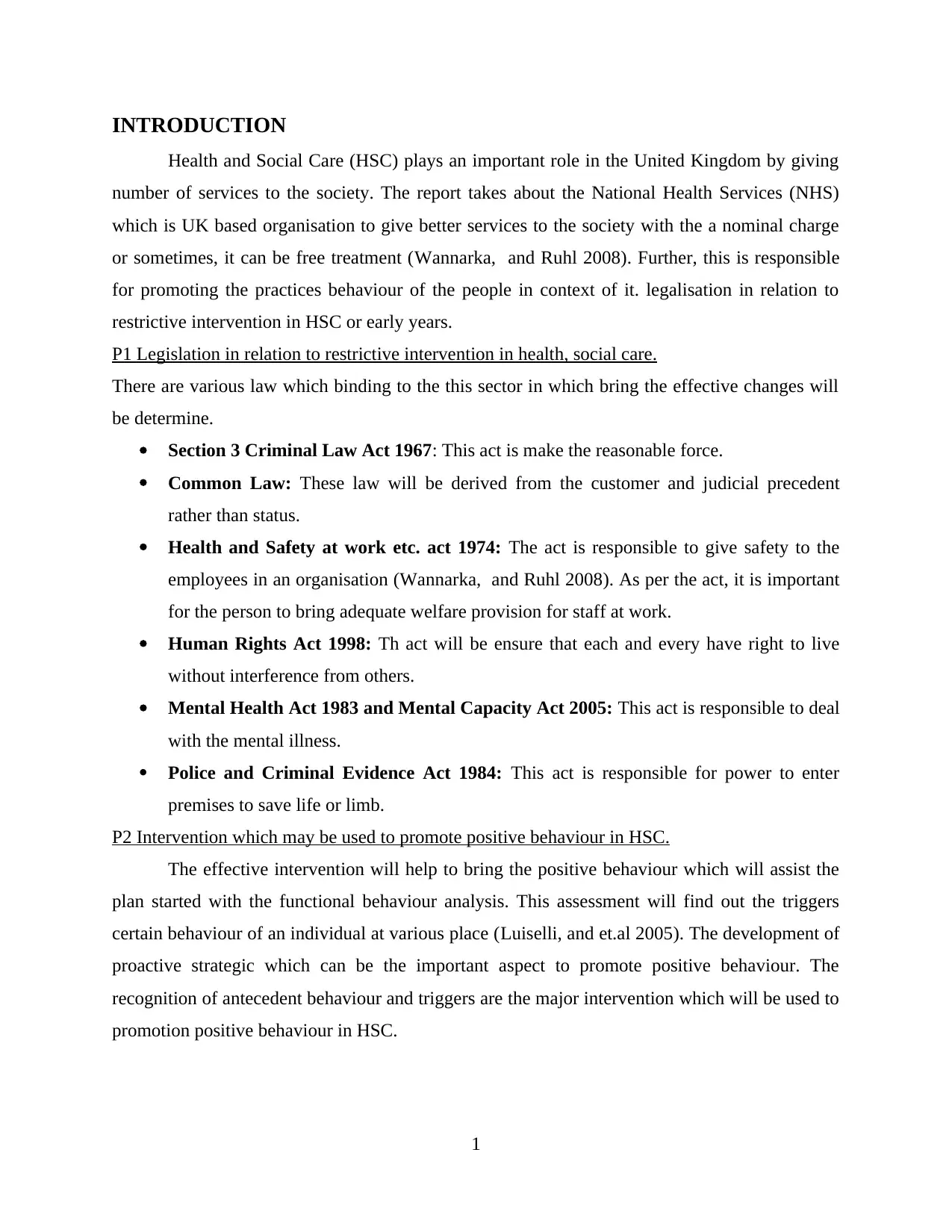
INTRODUCTION
Health and Social Care (HSC) plays an important role in the United Kingdom by giving
number of services to the society. The report takes about the National Health Services (NHS)
which is UK based organisation to give better services to the society with the a nominal charge
or sometimes, it can be free treatment (Wannarka, and Ruhl 2008). Further, this is responsible
for promoting the practices behaviour of the people in context of it. legalisation in relation to
restrictive intervention in HSC or early years.
P1 Legislation in relation to restrictive intervention in health, social care.
There are various law which binding to the this sector in which bring the effective changes will
be determine.
Section 3 Criminal Law Act 1967: This act is make the reasonable force.
Common Law: These law will be derived from the customer and judicial precedent
rather than status.
Health and Safety at work etc. act 1974: The act is responsible to give safety to the
employees in an organisation (Wannarka, and Ruhl 2008). As per the act, it is important
for the person to bring adequate welfare provision for staff at work.
Human Rights Act 1998: Th act will be ensure that each and every have right to live
without interference from others.
Mental Health Act 1983 and Mental Capacity Act 2005: This act is responsible to deal
with the mental illness.
Police and Criminal Evidence Act 1984: This act is responsible for power to enter
premises to save life or limb.
P2 Intervention which may be used to promote positive behaviour in HSC.
The effective intervention will help to bring the positive behaviour which will assist the
plan started with the functional behaviour analysis. This assessment will find out the triggers
certain behaviour of an individual at various place (Luiselli, and et.al 2005). The development of
proactive strategic which can be the important aspect to promote positive behaviour. The
recognition of antecedent behaviour and triggers are the major intervention which will be used to
promotion positive behaviour in HSC.
1
Health and Social Care (HSC) plays an important role in the United Kingdom by giving
number of services to the society. The report takes about the National Health Services (NHS)
which is UK based organisation to give better services to the society with the a nominal charge
or sometimes, it can be free treatment (Wannarka, and Ruhl 2008). Further, this is responsible
for promoting the practices behaviour of the people in context of it. legalisation in relation to
restrictive intervention in HSC or early years.
P1 Legislation in relation to restrictive intervention in health, social care.
There are various law which binding to the this sector in which bring the effective changes will
be determine.
Section 3 Criminal Law Act 1967: This act is make the reasonable force.
Common Law: These law will be derived from the customer and judicial precedent
rather than status.
Health and Safety at work etc. act 1974: The act is responsible to give safety to the
employees in an organisation (Wannarka, and Ruhl 2008). As per the act, it is important
for the person to bring adequate welfare provision for staff at work.
Human Rights Act 1998: Th act will be ensure that each and every have right to live
without interference from others.
Mental Health Act 1983 and Mental Capacity Act 2005: This act is responsible to deal
with the mental illness.
Police and Criminal Evidence Act 1984: This act is responsible for power to enter
premises to save life or limb.
P2 Intervention which may be used to promote positive behaviour in HSC.
The effective intervention will help to bring the positive behaviour which will assist the
plan started with the functional behaviour analysis. This assessment will find out the triggers
certain behaviour of an individual at various place (Luiselli, and et.al 2005). The development of
proactive strategic which can be the important aspect to promote positive behaviour. The
recognition of antecedent behaviour and triggers are the major intervention which will be used to
promotion positive behaviour in HSC.
1
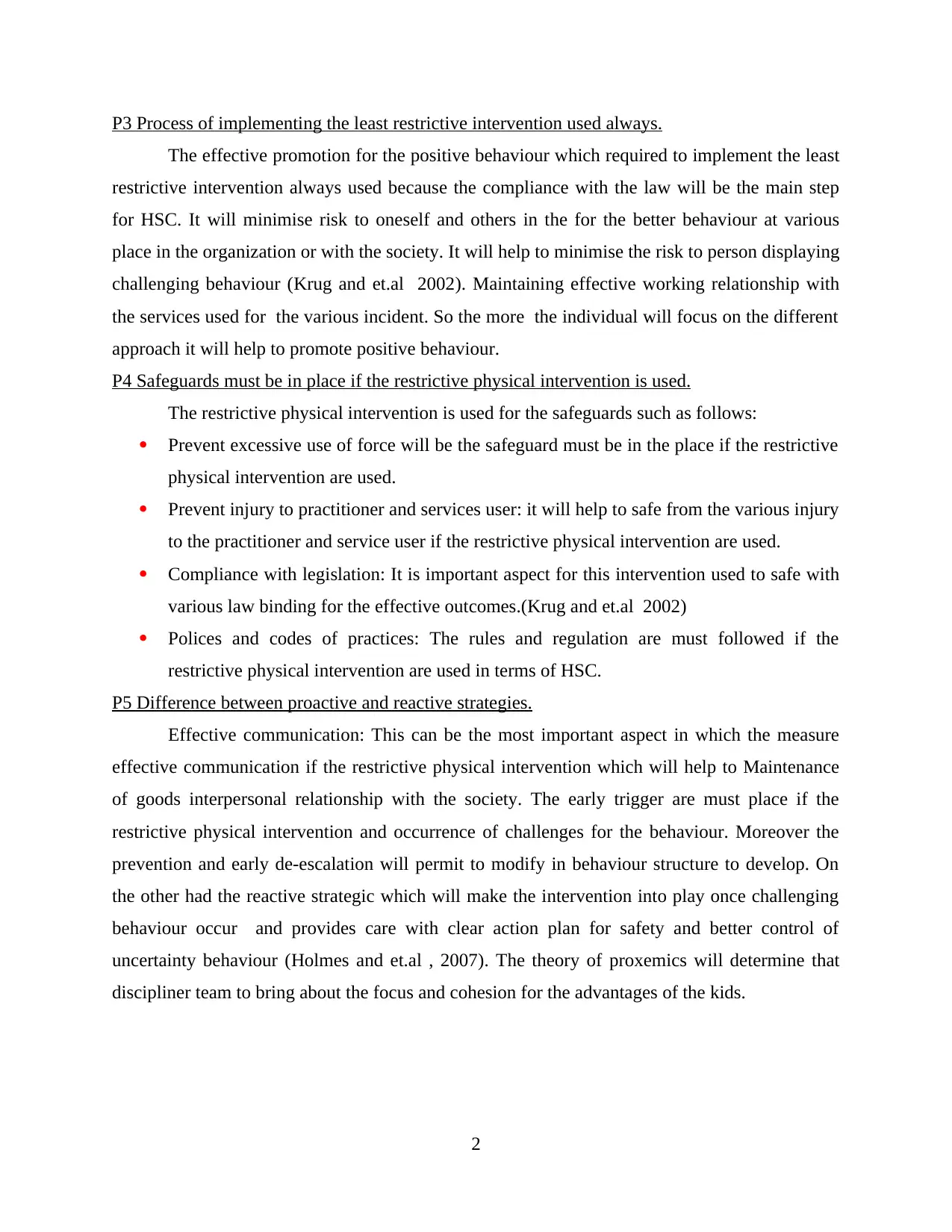
P3 Process of implementing the least restrictive intervention used always.
The effective promotion for the positive behaviour which required to implement the least
restrictive intervention always used because the compliance with the law will be the main step
for HSC. It will minimise risk to oneself and others in the for the better behaviour at various
place in the organization or with the society. It will help to minimise the risk to person displaying
challenging behaviour (Krug and et.al 2002). Maintaining effective working relationship with
the services used for the various incident. So the more the individual will focus on the different
approach it will help to promote positive behaviour.
P4 Safeguards must be in place if the restrictive physical intervention is used.
The restrictive physical intervention is used for the safeguards such as follows:
Prevent excessive use of force will be the safeguard must be in the place if the restrictive
physical intervention are used.
Prevent injury to practitioner and services user: it will help to safe from the various injury
to the practitioner and service user if the restrictive physical intervention are used.
Compliance with legislation: It is important aspect for this intervention used to safe with
various law binding for the effective outcomes.(Krug and et.al 2002)
Polices and codes of practices: The rules and regulation are must followed if the
restrictive physical intervention are used in terms of HSC.
P5 Difference between proactive and reactive strategies.
Effective communication: This can be the most important aspect in which the measure
effective communication if the restrictive physical intervention which will help to Maintenance
of goods interpersonal relationship with the society. The early trigger are must place if the
restrictive physical intervention and occurrence of challenges for the behaviour. Moreover the
prevention and early de-escalation will permit to modify in behaviour structure to develop. On
the other had the reactive strategic which will make the intervention into play once challenging
behaviour occur and provides care with clear action plan for safety and better control of
uncertainty behaviour (Holmes and et.al , 2007). The theory of proxemics will determine that
discipliner team to bring about the focus and cohesion for the advantages of the kids.
2
The effective promotion for the positive behaviour which required to implement the least
restrictive intervention always used because the compliance with the law will be the main step
for HSC. It will minimise risk to oneself and others in the for the better behaviour at various
place in the organization or with the society. It will help to minimise the risk to person displaying
challenging behaviour (Krug and et.al 2002). Maintaining effective working relationship with
the services used for the various incident. So the more the individual will focus on the different
approach it will help to promote positive behaviour.
P4 Safeguards must be in place if the restrictive physical intervention is used.
The restrictive physical intervention is used for the safeguards such as follows:
Prevent excessive use of force will be the safeguard must be in the place if the restrictive
physical intervention are used.
Prevent injury to practitioner and services user: it will help to safe from the various injury
to the practitioner and service user if the restrictive physical intervention are used.
Compliance with legislation: It is important aspect for this intervention used to safe with
various law binding for the effective outcomes.(Krug and et.al 2002)
Polices and codes of practices: The rules and regulation are must followed if the
restrictive physical intervention are used in terms of HSC.
P5 Difference between proactive and reactive strategies.
Effective communication: This can be the most important aspect in which the measure
effective communication if the restrictive physical intervention which will help to Maintenance
of goods interpersonal relationship with the society. The early trigger are must place if the
restrictive physical intervention and occurrence of challenges for the behaviour. Moreover the
prevention and early de-escalation will permit to modify in behaviour structure to develop. On
the other had the reactive strategic which will make the intervention into play once challenging
behaviour occur and provides care with clear action plan for safety and better control of
uncertainty behaviour (Holmes and et.al , 2007). The theory of proxemics will determine that
discipliner team to bring about the focus and cohesion for the advantages of the kids.
2
Secure Best Marks with AI Grader
Need help grading? Try our AI Grader for instant feedback on your assignments.
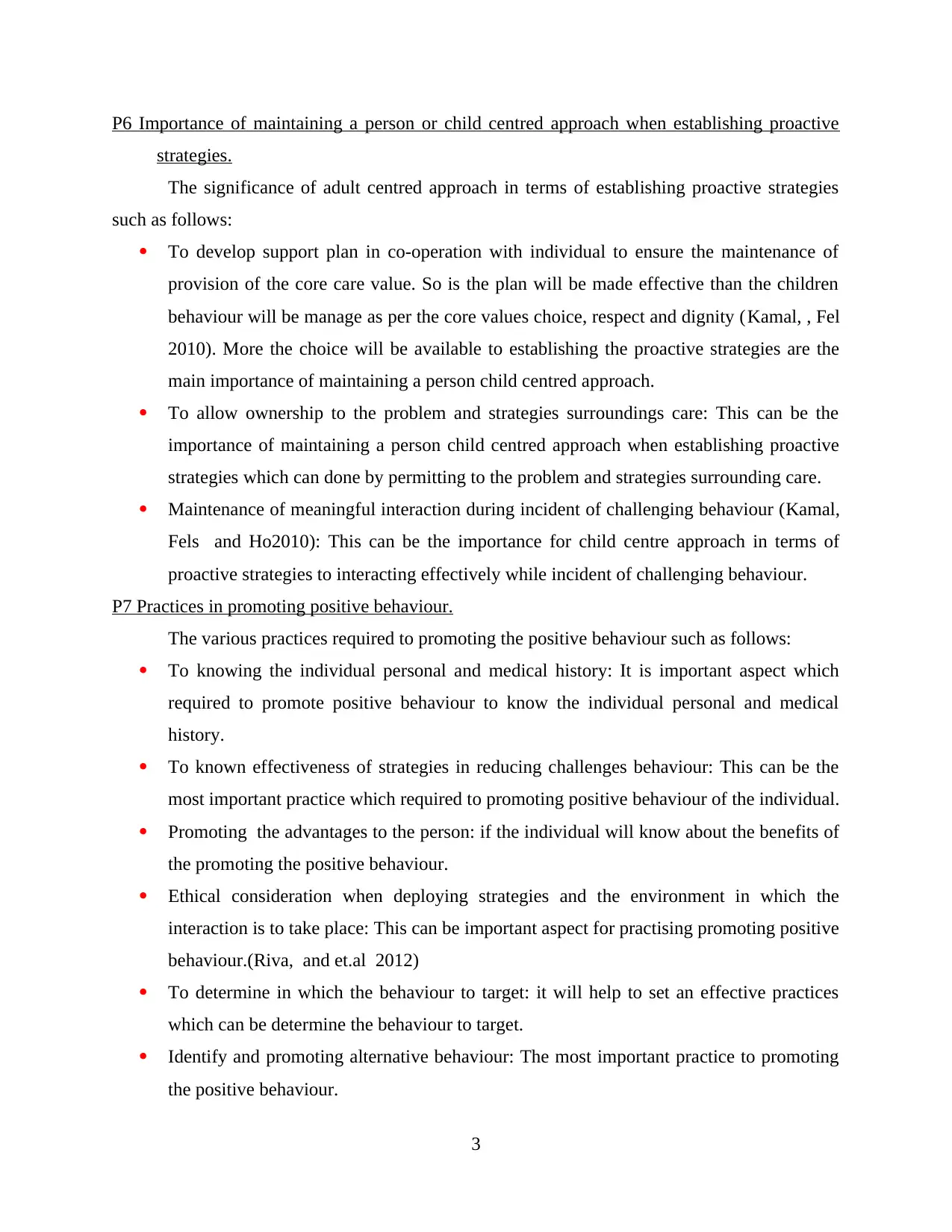
P6 Importance of maintaining a person or child centred approach when establishing proactive
strategies.
The significance of adult centred approach in terms of establishing proactive strategies
such as follows:
To develop support plan in co-operation with individual to ensure the maintenance of
provision of the core care value. So is the plan will be made effective than the children
behaviour will be manage as per the core values choice, respect and dignity (Kamal, , Fel
2010). More the choice will be available to establishing the proactive strategies are the
main importance of maintaining a person child centred approach.
To allow ownership to the problem and strategies surroundings care: This can be the
importance of maintaining a person child centred approach when establishing proactive
strategies which can done by permitting to the problem and strategies surrounding care.
Maintenance of meaningful interaction during incident of challenging behaviour (Kamal,
Fels and Ho2010): This can be the importance for child centre approach in terms of
proactive strategies to interacting effectively while incident of challenging behaviour.
P7 Practices in promoting positive behaviour.
The various practices required to promoting the positive behaviour such as follows:
To knowing the individual personal and medical history: It is important aspect which
required to promote positive behaviour to know the individual personal and medical
history.
To known effectiveness of strategies in reducing challenges behaviour: This can be the
most important practice which required to promoting positive behaviour of the individual.
Promoting the advantages to the person: if the individual will know about the benefits of
the promoting the positive behaviour.
Ethical consideration when deploying strategies and the environment in which the
interaction is to take place: This can be important aspect for practising promoting positive
behaviour.(Riva, and et.al 2012)
To determine in which the behaviour to target: it will help to set an effective practices
which can be determine the behaviour to target.
Identify and promoting alternative behaviour: The most important practice to promoting
the positive behaviour.
3
strategies.
The significance of adult centred approach in terms of establishing proactive strategies
such as follows:
To develop support plan in co-operation with individual to ensure the maintenance of
provision of the core care value. So is the plan will be made effective than the children
behaviour will be manage as per the core values choice, respect and dignity (Kamal, , Fel
2010). More the choice will be available to establishing the proactive strategies are the
main importance of maintaining a person child centred approach.
To allow ownership to the problem and strategies surroundings care: This can be the
importance of maintaining a person child centred approach when establishing proactive
strategies which can done by permitting to the problem and strategies surrounding care.
Maintenance of meaningful interaction during incident of challenging behaviour (Kamal,
Fels and Ho2010): This can be the importance for child centre approach in terms of
proactive strategies to interacting effectively while incident of challenging behaviour.
P7 Practices in promoting positive behaviour.
The various practices required to promoting the positive behaviour such as follows:
To knowing the individual personal and medical history: It is important aspect which
required to promote positive behaviour to know the individual personal and medical
history.
To known effectiveness of strategies in reducing challenges behaviour: This can be the
most important practice which required to promoting positive behaviour of the individual.
Promoting the advantages to the person: if the individual will know about the benefits of
the promoting the positive behaviour.
Ethical consideration when deploying strategies and the environment in which the
interaction is to take place: This can be important aspect for practising promoting positive
behaviour.(Riva, and et.al 2012)
To determine in which the behaviour to target: it will help to set an effective practices
which can be determine the behaviour to target.
Identify and promoting alternative behaviour: The most important practice to promoting
the positive behaviour.
3

Identify strategies to reducing negative behaviour and effect planning: It is important
thing which required to promote the positive behaviour by identifying to reduce the
negative behaviour and effect planning.(Riva, and et.al 2012)
P8 Types of challenging behaviour.
There are various types of challenging behaviour such as follows:
Self Injury: Head banging, scratching or picking skin, throwing self to floor are the
major self injury which can be challenged for the behaviour.
Physical aggression: This can be the another challenges for the behaviour which is
aggression in terms of biting, hitting, throwing, choking, verbal threat
Classroom disruption: This is also an major challenges for the behaviour which is
classroom disruption
Stereotyped behaviour: The gesture used by the children are the most important aspect
in the behaviour, hand tricking mouthing, body rocking are the some of stereotyped
behaviour.
Non-compliance: This types of challenges behaviour in which the children not
responding to direction defiance, bickering, jumping and crawling:
P9 Steps to be taken for maintain dignity and respect of an individual when responding to an
incident of challenging behaviour.
For maintaining dignity and respect of an individual when responding to an incident of challenge
behaviour such as follows:
Keep calm: This can be the common method in which the most important aspect for the
maintaining dignity and respect of an individual when responding to an incident of
challenging behaviour which required to keep calm in such step.(Nicholson and et.al
2008)
Lowering tone and volume of voice: This can be the another aspect for maintaining
dignity and respect of an individual when responding by lowering tone and volume of
voice.
P10 Step to be taken to check on
There are various step to check on such as follows:
4
thing which required to promote the positive behaviour by identifying to reduce the
negative behaviour and effect planning.(Riva, and et.al 2012)
P8 Types of challenging behaviour.
There are various types of challenging behaviour such as follows:
Self Injury: Head banging, scratching or picking skin, throwing self to floor are the
major self injury which can be challenged for the behaviour.
Physical aggression: This can be the another challenges for the behaviour which is
aggression in terms of biting, hitting, throwing, choking, verbal threat
Classroom disruption: This is also an major challenges for the behaviour which is
classroom disruption
Stereotyped behaviour: The gesture used by the children are the most important aspect
in the behaviour, hand tricking mouthing, body rocking are the some of stereotyped
behaviour.
Non-compliance: This types of challenges behaviour in which the children not
responding to direction defiance, bickering, jumping and crawling:
P9 Steps to be taken for maintain dignity and respect of an individual when responding to an
incident of challenging behaviour.
For maintaining dignity and respect of an individual when responding to an incident of challenge
behaviour such as follows:
Keep calm: This can be the common method in which the most important aspect for the
maintaining dignity and respect of an individual when responding to an incident of
challenging behaviour which required to keep calm in such step.(Nicholson and et.al
2008)
Lowering tone and volume of voice: This can be the another aspect for maintaining
dignity and respect of an individual when responding by lowering tone and volume of
voice.
P10 Step to be taken to check on
There are various step to check on such as follows:
4
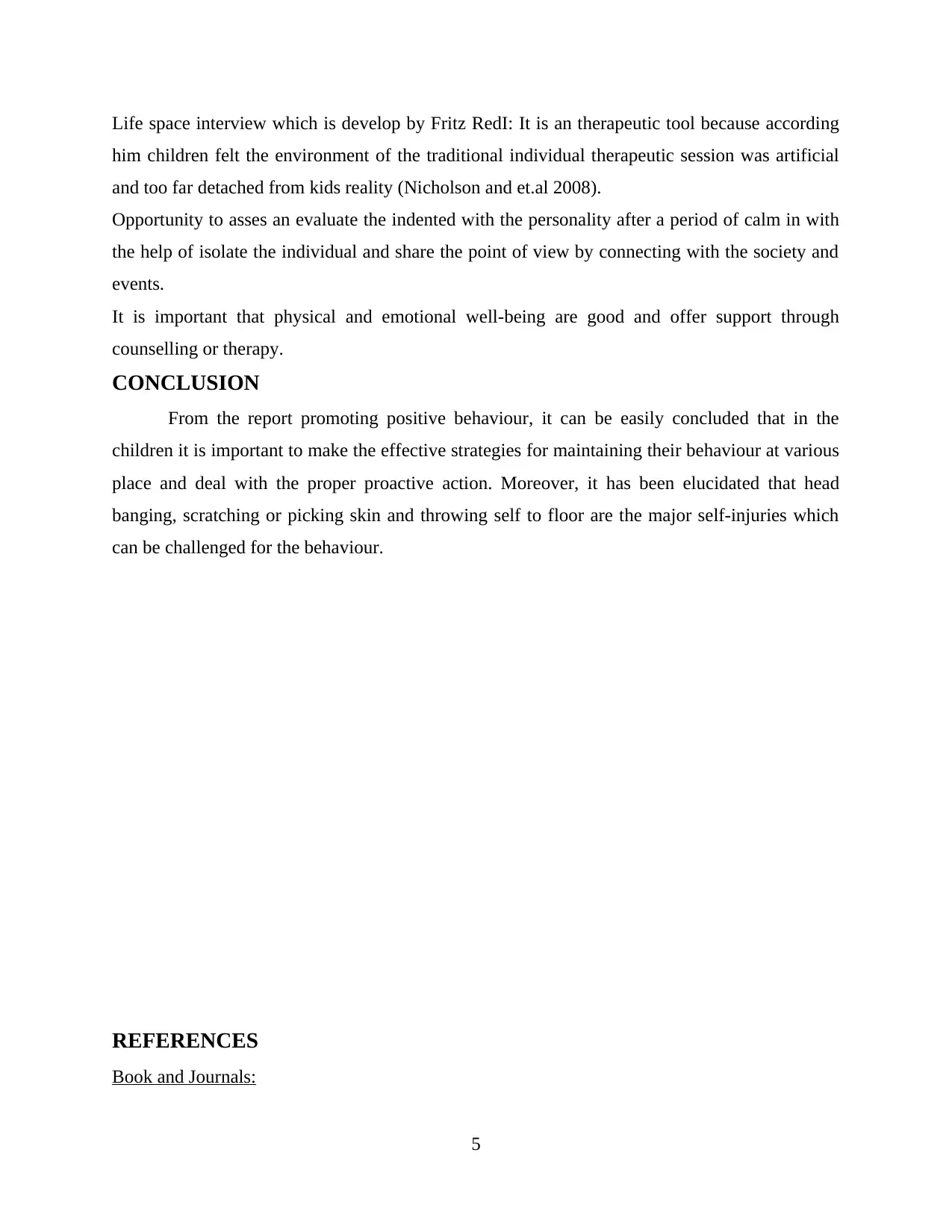
Life space interview which is develop by Fritz RedI: It is an therapeutic tool because according
him children felt the environment of the traditional individual therapeutic session was artificial
and too far detached from kids reality (Nicholson and et.al 2008).
Opportunity to asses an evaluate the indented with the personality after a period of calm in with
the help of isolate the individual and share the point of view by connecting with the society and
events.
It is important that physical and emotional well-being are good and offer support through
counselling or therapy.
CONCLUSION
From the report promoting positive behaviour, it can be easily concluded that in the
children it is important to make the effective strategies for maintaining their behaviour at various
place and deal with the proper proactive action. Moreover, it has been elucidated that head
banging, scratching or picking skin and throwing self to floor are the major self-injuries which
can be challenged for the behaviour.
REFERENCES
Book and Journals:
5
him children felt the environment of the traditional individual therapeutic session was artificial
and too far detached from kids reality (Nicholson and et.al 2008).
Opportunity to asses an evaluate the indented with the personality after a period of calm in with
the help of isolate the individual and share the point of view by connecting with the society and
events.
It is important that physical and emotional well-being are good and offer support through
counselling or therapy.
CONCLUSION
From the report promoting positive behaviour, it can be easily concluded that in the
children it is important to make the effective strategies for maintaining their behaviour at various
place and deal with the proper proactive action. Moreover, it has been elucidated that head
banging, scratching or picking skin and throwing self to floor are the major self-injuries which
can be challenged for the behaviour.
REFERENCES
Book and Journals:
5
Paraphrase This Document
Need a fresh take? Get an instant paraphrase of this document with our AI Paraphraser
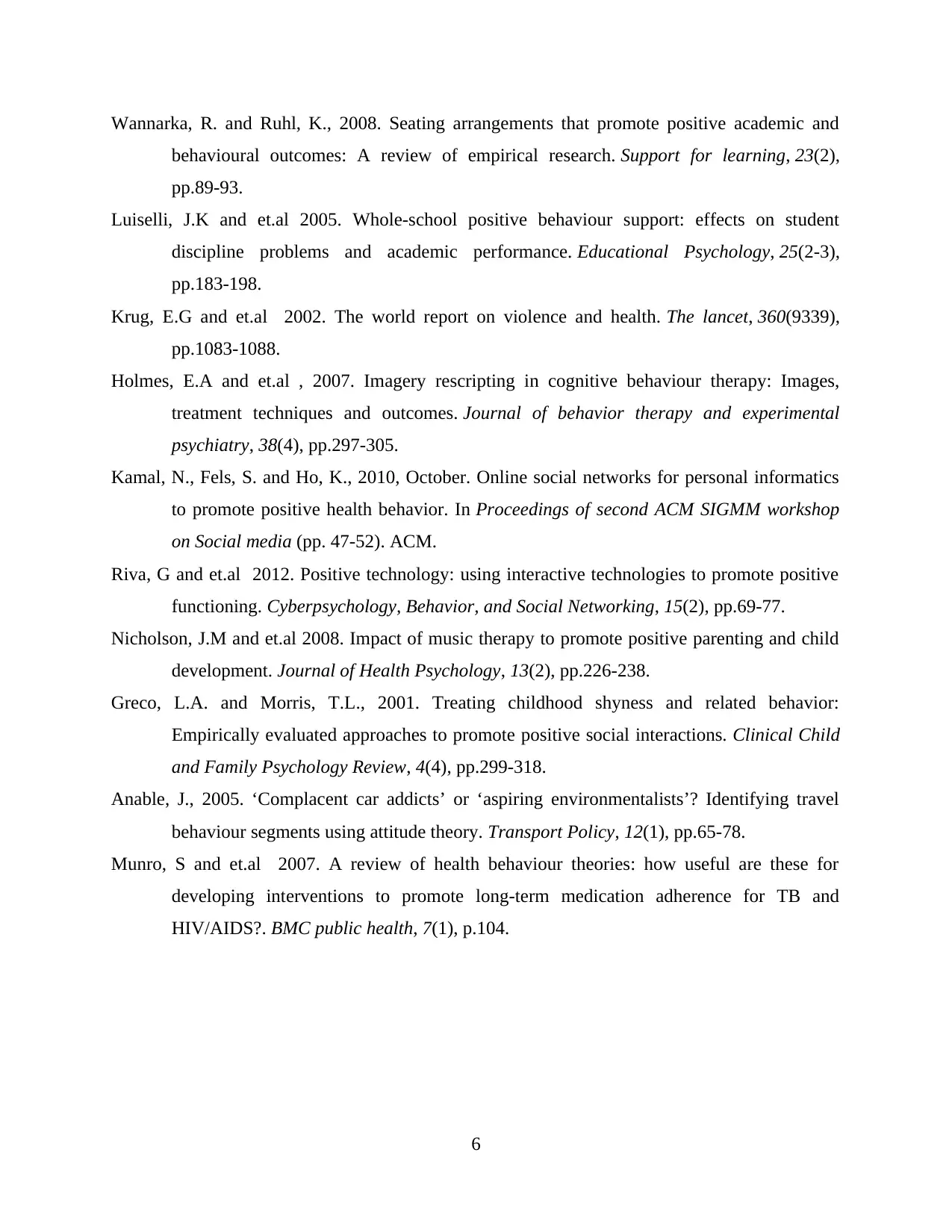
Wannarka, R. and Ruhl, K., 2008. Seating arrangements that promote positive academic and
behavioural outcomes: A review of empirical research. Support for learning, 23(2),
pp.89-93.
Luiselli, J.K and et.al 2005. Whole‐school positive behaviour support: effects on student
discipline problems and academic performance. Educational Psychology, 25(2-3),
pp.183-198.
Krug, E.G and et.al 2002. The world report on violence and health. The lancet, 360(9339),
pp.1083-1088.
Holmes, E.A and et.al , 2007. Imagery rescripting in cognitive behaviour therapy: Images,
treatment techniques and outcomes. Journal of behavior therapy and experimental
psychiatry, 38(4), pp.297-305.
Kamal, N., Fels, S. and Ho, K., 2010, October. Online social networks for personal informatics
to promote positive health behavior. In Proceedings of second ACM SIGMM workshop
on Social media (pp. 47-52). ACM.
Riva, G and et.al 2012. Positive technology: using interactive technologies to promote positive
functioning. Cyberpsychology, Behavior, and Social Networking, 15(2), pp.69-77.
Nicholson, J.M and et.al 2008. Impact of music therapy to promote positive parenting and child
development. Journal of Health Psychology, 13(2), pp.226-238.
Greco, L.A. and Morris, T.L., 2001. Treating childhood shyness and related behavior:
Empirically evaluated approaches to promote positive social interactions. Clinical Child
and Family Psychology Review, 4(4), pp.299-318.
Anable, J., 2005. ‘Complacent car addicts’ or ‘aspiring environmentalists’? Identifying travel
behaviour segments using attitude theory. Transport Policy, 12(1), pp.65-78.
Munro, S and et.al 2007. A review of health behaviour theories: how useful are these for
developing interventions to promote long-term medication adherence for TB and
HIV/AIDS?. BMC public health, 7(1), p.104.
6
behavioural outcomes: A review of empirical research. Support for learning, 23(2),
pp.89-93.
Luiselli, J.K and et.al 2005. Whole‐school positive behaviour support: effects on student
discipline problems and academic performance. Educational Psychology, 25(2-3),
pp.183-198.
Krug, E.G and et.al 2002. The world report on violence and health. The lancet, 360(9339),
pp.1083-1088.
Holmes, E.A and et.al , 2007. Imagery rescripting in cognitive behaviour therapy: Images,
treatment techniques and outcomes. Journal of behavior therapy and experimental
psychiatry, 38(4), pp.297-305.
Kamal, N., Fels, S. and Ho, K., 2010, October. Online social networks for personal informatics
to promote positive health behavior. In Proceedings of second ACM SIGMM workshop
on Social media (pp. 47-52). ACM.
Riva, G and et.al 2012. Positive technology: using interactive technologies to promote positive
functioning. Cyberpsychology, Behavior, and Social Networking, 15(2), pp.69-77.
Nicholson, J.M and et.al 2008. Impact of music therapy to promote positive parenting and child
development. Journal of Health Psychology, 13(2), pp.226-238.
Greco, L.A. and Morris, T.L., 2001. Treating childhood shyness and related behavior:
Empirically evaluated approaches to promote positive social interactions. Clinical Child
and Family Psychology Review, 4(4), pp.299-318.
Anable, J., 2005. ‘Complacent car addicts’ or ‘aspiring environmentalists’? Identifying travel
behaviour segments using attitude theory. Transport Policy, 12(1), pp.65-78.
Munro, S and et.al 2007. A review of health behaviour theories: how useful are these for
developing interventions to promote long-term medication adherence for TB and
HIV/AIDS?. BMC public health, 7(1), p.104.
6

Scanlon, T.M and et.al 2007. Positive feedbacks promote power-law clustering of Kalahari
vegetation. Nature, 449(7159), p.209.
7
vegetation. Nature, 449(7159), p.209.
7

8
1 out of 10
Related Documents
Your All-in-One AI-Powered Toolkit for Academic Success.
+13062052269
info@desklib.com
Available 24*7 on WhatsApp / Email
![[object Object]](/_next/static/media/star-bottom.7253800d.svg)
Unlock your academic potential
© 2024 | Zucol Services PVT LTD | All rights reserved.





